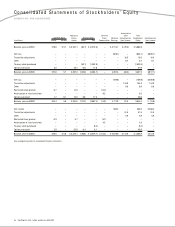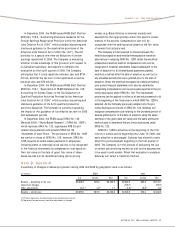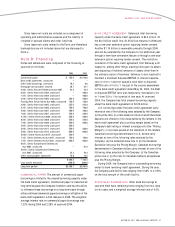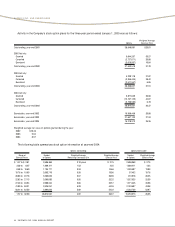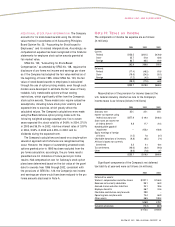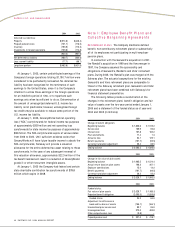Safeway 2004 Annual Report Download - page 42
Download and view the complete annual report
Please find page 42 of the 2004 Safeway annual report below. You can navigate through the pages in the report by either clicking on the pages listed below, or by using the keyword search tool below to find specific information within the annual report.
40 SAFEWAY INC. 2004 ANNUAL REPORT
SAFEWAY INC. AND SUBSIDIARIES
The Company adopted SFAS No. 142, “Goodwill and
Other Intangible Assets,” on December 30, 2001. Under the
transitional provisions of SFAS No. 142, the Company’s
goodwill was tested for impairment as of December 30,
2001. Each of the Company’s reporting units were tested for
impairment by comparing the fair value of each reporting
unit with its carrying value. Fair value was determined
based on a valuation study performed by an independent
third party who primarily considered the discounted cash
flow, guideline company and similar transaction methods.
As a result of the Company’s impairment test, the Company
recorded an impairment loss to reduce the carrying value of
goodwill at Dominick’s by $589.0 million and Randall’s by
$111.0 million to its implied fair value. Impairment in both
cases was due to a combination of factors including
acquisition price, post-acquisition capital expenditures and
operating performance. In accordance with SFAS No. 142,
the impairment charge was reflected as a cumulative effect
of accounting change in the Company’s statement of
operations.
As required by SFAS No. 142, Safeway tested goodwill
for impairment again in the fourth quarter of 2002, which
represents the annual impairment testing date selected by
Safeway. Fair value was determined based on a valuation
study performed by an independent third party which
primarily considered the discounted cash flow and guideline
company method. As a result of this annual review, Safeway
recorded an impairment charge for Dominick’s goodwill of
$583.8 million and for Randall’s goodwill of $704.2 million.
These additional charges reflect declining multiples in the
retail grocery industry and operating performance.
Also in the fourth quarter of 2003, Safeway performed
its annual review of goodwill. Fair value was determined
based on a valuation study performed by an independent
third party which primarily considered the discounted cash
flow and guideline company method. As a result of this
annual review, Safeway recorded an impairment charge for
Randall’s goodwill of $447.7 million. The additional charges
reflect declining multiples in the retail grocery industry and
operating performance. There was no remaining goodwill
for Dominick’s or Randall’s on Safeway’s consolidated
balance sheet at year-end 2003.
Safeway completed its annual impairment test in the
fourth quarter of 2004. Fair value was determined based on
a valuation study performed by an independent third party
which primarily considered the discounted cash flow and
guideline company method. As a result of this annual review,
Safeway concluded that no impairment charge was required.
Note C: Store Closing and
Impairment Charges
IMPAIRMENT WRITE-DOWNS Safeway recognized
impairment charges on the write-down of long-lived assets
of $39.4 million in 2004, $344.9 million in 2003 and $213.1
million in 2002. This includes Dominick’s impairment
charges of $311.4 million in 2003 and $201.3 million in
2002. These charges are included as a component of
operating and administrative expense.
In November 2002, Safeway announced the decision to
sell Dominick’s and exit the Chicago market due to labor
issues. In accordance with SFAS No. 144, Safeway recorded
a pre-tax charge for the impairment of long-lived assets of
$201.3 million in the fourth quarter of 2002 to adjust
Dominick’s to its estimated fair market value less cost to sell.
In the first 36 weeks of 2003, Safeway reduced the
carrying value of Dominick’s in part by writing down an
additional $120.7 million of long-lived assets, based on
indications of value received during the sale process. In
November 2003, Safeway announced that it was taking
Dominick’s off the market. Safeway reclassified Dominick’s
from an “asset held for sale” to “asset held and used” and
adjusted Dominick’s individual long-lived assets to the
lower of cost or fair value. As a result, in the fourth quarter
of 2003, Safeway incurred a pre-tax, long-lived asset
impairment charge of $190.7 million.
STORE LEASE EXIT COSTS The reserve for store lease
exit costs includes the following activity for 2004, 2003 and
2002 (in millions):
2004 2003 2002
Beginning balance $129.1 $132.1 $132.4
Provision for estimated
net future cash flows of
additional closed stores(1) 55.1 3.7 30.6
Net cash flows, interest accretion,
changes in estimates of net
future cash flows (17.1) (6.7) (30.9)
Ending balance $167.1 $129.1 $132.1
(1) Estimated net future cash flows represents future minimum lease payments and
related ancillary costs from the date of closure to the end of the remaining lease
term, net of estimated cost recoveries that may be achieved through subletting
properties or through favorable lease terminations.






